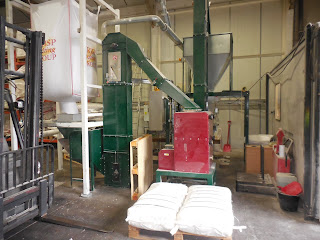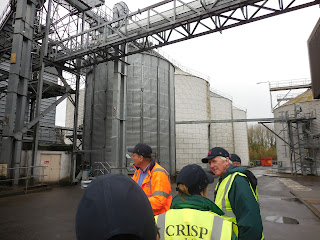"Insist on Crisp" isn't quite up there with "Put some pork on your fork" as far as marketing slogans go but it almost rhymes and that's got to be worth something. I visited Crisp Maltings in Ryburgh the other week for an excellent tour of the site.
They have a few different types of maltings there.
First we saw the eight tonne pilot maltings which has a combined steeping, germination and kilning vessel.
At the pilot maltings at work we have kilns separate from the steeping and germination vessels, but at 50kg capacity each are on a rather different scale.
Then we were off to our next port of call, the floor maltings.
As you would expect at a floor maltings it was quite historic, dating from 1870.
There are three floors, each of which can take seven tonnes of malt, the grain being laid on the floor 10cm deep.
There has been some modernisation so there is air conditioning rather than just windows.
Up at the top were barley storage areas, though these aren't used anymore.
All three floors of malt are kilned together, the kilning taking three days. Though the floor maltings was closed for servicing whilst we visited it's normally in pretty much constant use.
Crisp store 40,000 tonnes of barley on site.
It's analysed on arrival and if not up to scratch is rejected, though the rejection rate is less than 1%.
The central laboratory facilities are on site too.
For microbrewers they mill grain, and the mill is working at close to capacity.
Barley is dried gently (max temp 40-44°C) to less than 12% moisture for storage.
If the farmers bring grain with greater than 15% moisture they'll be charged for the drying!
To keep costs down they have their own effluent treatment plant and use borehole water.
Most of the malting is carried out on two mid 90s plants, each with a 220 tonne batch size. Sadly none of my photos from inside the big plant turned out well due to the humid atmosphere.
They have flat bottomed steeping vessels. This gives a shallower and more uniform bed depth than a conical bottomed steep tank, but does use more water and is harder to clean.They steep to 44-46% moisture, the moisture and temperature varying slightly depending on which type of malt is being made.
The circular germination vessels have a bed depth of 1.8m over a wedge wire floor, with a giracleur to level and turn the grains. Two steeps are used, with a total germination time of 48 hours. Air can be vented or recirculated to control temperature. Approximately 0.5% moisture is lost each day.
In the kiln heat is first applied to the grains with high air flow and low temperature. When the air off humidity is less than 100% the temperature can be increased, the final kiln temp ranging from 85-110°C depending on the type of malt being made. Kilning takes 24 hours. The two kilns run in staggered tandem so heat can be moved back and forth between the kilns e.g. after the break point (less than 100% humidity) air one kiln can be used to heat the other kiln. The bed depth is 1m.
After kilning the malt is analysed and goes to storage. Batches are blended to meet customer specifications. Big brewers can ask for their own specifications, microbrewers get what the regionals asked for!

















I went around Crisp in January. First time I'd ever been in a maltings. Dead interesting and very nice people working there.
ReplyDeleteYes, totally agree.
ReplyDelete